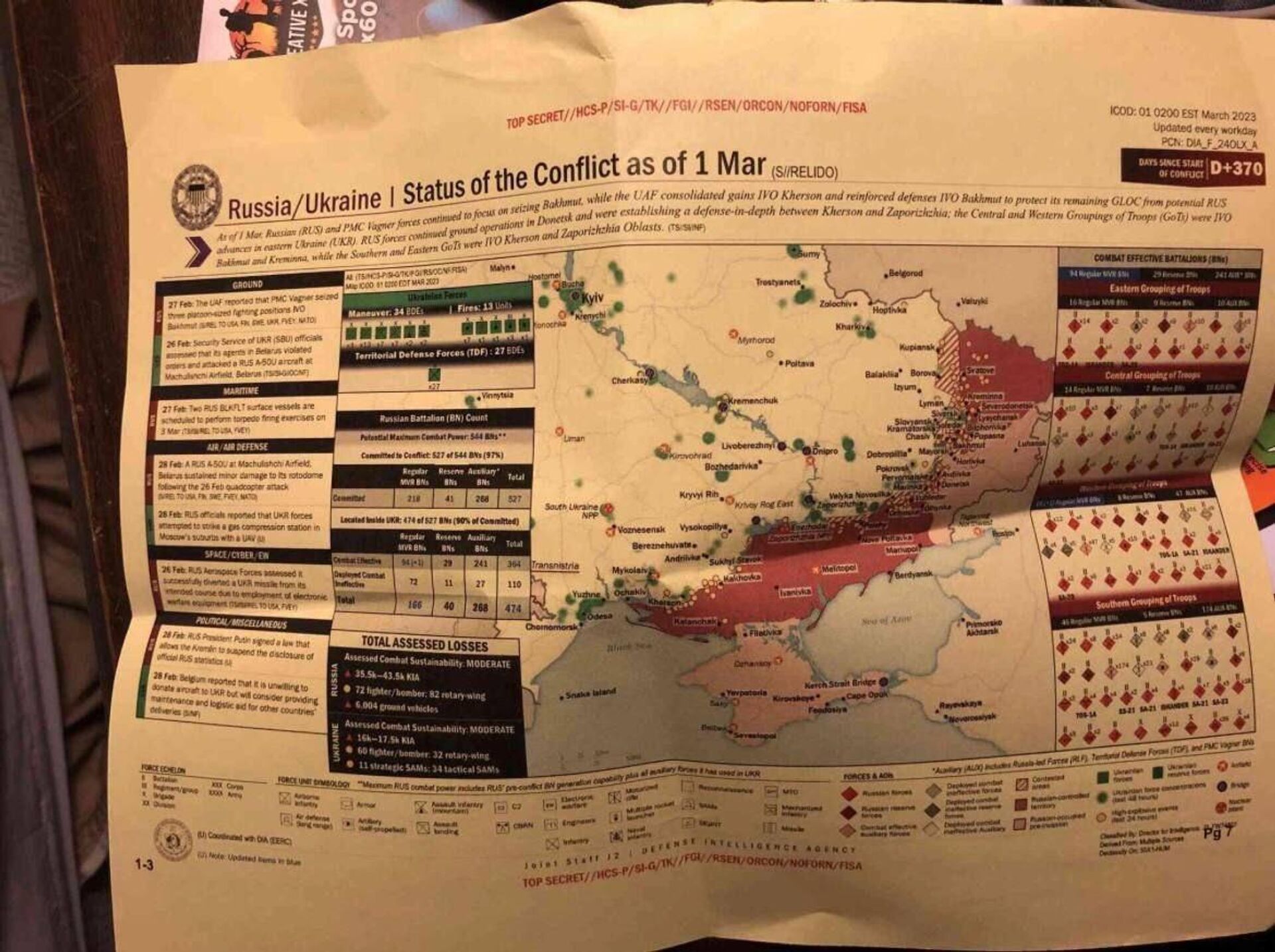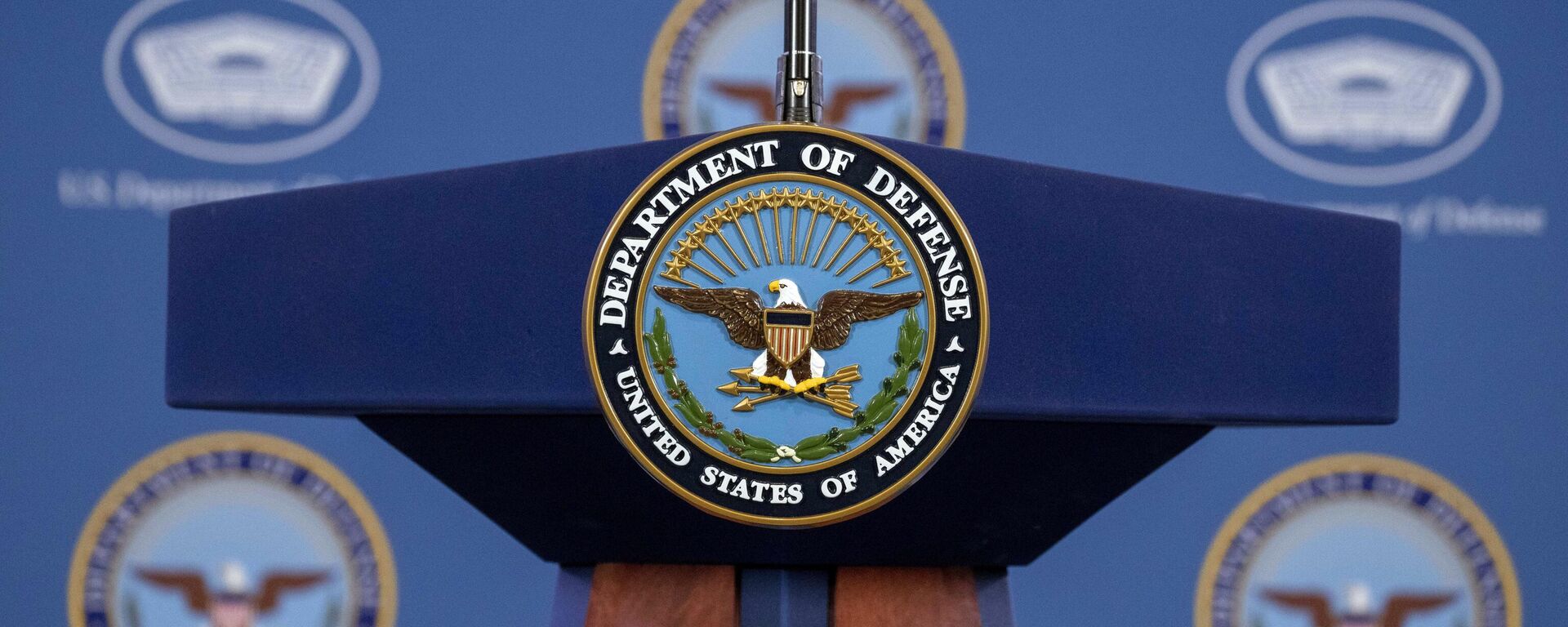https://sputnikglobe.com/20230412/pentagon-leaks-5-key-revelations-1109396000.html
Pentagon Leaks: 5 Key Revelations
Pentagon Leaks: 5 Key Revelations
Sputnik International
The appearance online of what look like secret documents concerning US intelligence assessments of the conflict in Ukraine and their proliferation by media have sparked widespread controversy, with observers divided into two broad camps: those who believe the docs are genuine, and those who have reservations. Here’s what we know right now.
2023-04-12T16:22+0000
2023-04-12T16:22+0000
2023-04-16T19:20+0000
analysis
ukraine
leaks
pentagon leaks
leaks
information leaks
media leaks
info leaks
data leaks
https://cdn1.img.sputnikglobe.com/img/106247/87/1062478795_0:131:1920:1211_1920x0_80_0_0_b80b3ab1cf080334dccc0a9d55880d40.jpg
The leak of over 100 photographed pages of documents dated between late February and early March and labeled “Secret,” “Top Secret,” and “NOFORN” (not for viewing by foreign nationals) related to the ongoing NATO-Russia proxy war in Ukraine continues to generate global headlines. It has also had a real world impact, with Washington officials scrambling to contact and reassure allies amid embarrassing revelations that the US has been spying on its own allies (although, of course, that’s nothing new to anyone who’s been paying attention).Key TakeawaysAs the dust settles and the potential security implications of the leaks (including, potentially, the judiciousness of further US and NATO military assistance to Kiev), several facts seem to stand out among the info gleaned.1. A page from a “Top Secret” assessment from February highlights apparent major “force generation and sustainment shortfalls” within Ukraine’s Armed Forces, and warns that Kiev would be able to secure only “modest territorial gains” if it decided to launch a spring offensive.The assessment is significant because it highlights the contrast between the glum internal appraisal by the Pentagon, and the gung ho, everything-is-awesome sentiment expressed by officials in Washington and Brussels, and by President Joe Biden’s brash talk of Kiev’s impressive capabilities to conduct large-scale offensive operations with US support.2. Another significant document, also dating from February, highlights President Volodymyr Zelensky’s recommendation that Ukrainian forces carry out massed drone strikes against “Russian deployment locations in Russia’s Rostov Oblast,” and complaints that Kiev does not have the necessary long-range missile capabilities for such strikes.3. The leaks challenge longstanding claims by the Pentagon and the Ukrainian military about casualties. A document entitled “Top Secret – Status of the Conflict as of March 01, 2023” estimates total Russian losses could be up to 16,000-17,500 killed in action, and 61,000-71,500 on the Ukrainian side.That’s a far cry from the assessment by Joint Chiefs Chairman Mark Milley in November, which estimated Russian deaths at “well over” 100,000 troops, as well as the Ukrainian military’s pie in the sky “eliminated personnel” figures of 180,050 (i.e. nearly matching the 190,000 troop total that Western intelligence estimated were near Donbass in February 2022 before the escalation of the crisis). Ukrainian officials and Western media have sought to downplay these figures, accusing Russia of “doctoring” the stats (despite possible secondary corroboration) and assuring that Russian casualties are much higher, and Ukrainian ones much lower. Wherever the truth lies, the figures serve to undermine confidence in Ukraine’s NATO-supported and equipped army of super soldiers.4. Another key revelation relates to the extent of NATO involvement. While alliance officials have consistently assured that no Western forces are on the ground fighting against Russia, a “Top Secret” document dated March 23 indicates that nearly half-a-dozen NATO powers do in fact have “boots on the ground” in the form of special forces troops. These include Britain (50 troops), Latvia (17), France (15), the US (14), and the Netherlands (1).It’s unclear what exactly these forces are doing there. The document doesn’t say. Apparently realizing the grave implications of this information, Britain’s Defense Ministry offered a catch-all dismissal of the documents, assuring in a Tweet Tuesday that “the widely reported leak of alleged classified US information has demonstrated a serious level of inaccuracy,” and that “readers should be cautious about taking at face value allegations that have the potential to spread disinformation.”5. One final significant piece of information that can be gleaned from the documents relates to the state of Ukraine’s air defenses. A Pentagon assessment dated February 28 projected that Kiev’s stocks of Soviet-made Buk and S-300 missile systems – which make up almost 90 percent of the country’s air defenses, would be “fully depleted” by mid-April and May 3, respectively. A second slide from an assessment from February 23 predicts that Ukrainian forces’ frontline protection would be “completely reduced” by May 23.This information is significant because it seems to confirm that the US and its allies are running out of time to shore up their client’s air defense protection before Russia gains total air superiority similar to the kind its Air Force enjoyed in the counterterrorism operation in Syria, or the kind the US and its allies typically have when they decide to bomb a third world country.The US has promised to provide Ukraine with its bulky Patriot missile system and to ramp up deliveries of other anti-air weaponry, but observers have expressed concerns about the ability of the US military-industrial complex to ramp up production quickly enough, and questioned whether Washington will be willing to send additional sophisticated air defense hardware to a conflict zone where losses would mean a significant hit to US weapons makers if the equipment is lost.Skepticism is HealthyThe leak of the documents online, and the fact that they were picked up by major legacy media resources in the West, has caused understandable consternation in some circles about whether or not they are genuine. After all, these are the same newspapers, outlets, and television networks that have pumped out story after debunked Russia-related story over the years and decades, from the claim that Russia paid bounties to the Taliban* to kill US troops in Afghanistan, to the allegation that Moscow meddled in America’s elections in 2016 and secretly installed a "Manchurian Candidate" named Donald Trump.Ryabkov explained that since Washington is a key party to the Ukraine conflict and is waging a hybrid war against Russia, the documents may be a ploy to mislead the Russian side. “I’m not confirming anything, but understand that various scenarios are conceivable here,” he said.Publicly, at least, officials in Washington have treated the leaks as if they’re the real thing. Pentagon chief Lloyd Austin vowed that his department would “turn over every rock” until the “source” of the leaks was found and their extent clarified. CIA chief William Burns echoed Austin’s performance, calling the leaks “deeply unfortunate” and saying they were something the US government “takes extremely seriously.”Amid reports that the Pentagon has been trying to scrub the leaked docs from the net, Twitter CEO Elon Musk sarcastically quipped that “yeah, you can totally delete things from the internet – it works perfectly and doesn’t draw attention to whatever you were trying to hide at all.”Kiev, predictably, has blamed Moscow, calling the leaks a “Russian propaganda ploy.” Chinese media dismissed these assertions, suggesting that if Russia had gotten its hands on the documents, it would likely hold onto them and use them to its advantage against Ukraine and NATO instead of spreading them online.Kremlin spokesman Dmitry Peskov called the leaks "quite interesting." As for the suggestion that Moscow might somehow be involved, he said that "the tendency to constantly blame Russia for everything is a widespread disease right now."The truth about who leaked the documents and why may never be found. However, a stream of retired US officials, Washington-based security advisors, and CIA analysts have told Sputnik that the “leaks” may be an attempt by “dissenters” and “realists” within the US security state establishment to provide Washington with a much-needed “offramp” from the ever-escalating conflict with Russia in Ukraine before it turns into a world war.*The Taliban is an organization under UN sanctions for terrorism.
https://sputnikglobe.com/20230411/pentagon-leaks-show-washington-dissidents-want-offramp-from-ukraine-disaster-1109346941.html
ukraine
Sputnik International
feedback@sputniknews.com
+74956456601
MIA „Rossiya Segodnya“
2023
News
en_EN
Sputnik International
feedback@sputniknews.com
+74956456601
MIA „Rossiya Segodnya“
Sputnik International
feedback@sputniknews.com
+74956456601
MIA „Rossiya Segodnya“
pentagon leaks, reaction, key takeaways, reactions, response, russia, united states, ukraine, revelations, information, skepticism
pentagon leaks, reaction, key takeaways, reactions, response, russia, united states, ukraine, revelations, information, skepticism
Pentagon Leaks: 5 Key Revelations
16:22 GMT 12.04.2023 (Updated: 19:20 GMT 16.04.2023) The appearance online of what looks like secret documents concerning US intelligence assessments of the conflict in Ukraine and their proliferation by media have sparked widespread controversy, with observers divided into two broad camps: those who believe the docs are genuine, and those who have reservations. Here’s what we know right now.
The
leak of over 100 photographed pages of documents dated between late February and early March and labeled “Secret,” “Top Secret,” and “NOFORN” (not for viewing by foreign nationals) related to the ongoing NATO-Russia proxy war in Ukraine continues to generate global headlines. It has also had a real world impact, with Washington officials scrambling to contact and reassure allies amid embarrassing revelations that the US has been spying on its own allies (although, of course, that’s
nothing new to anyone who’s been paying attention).
As the dust settles and the potential security implications of the leaks (including, potentially, the judiciousness of further US and NATO military assistance to Kiev), several facts seem to stand out among the info gleaned.
1. A page from a “Top Secret” assessment from February highlights apparent major “force generation and sustainment shortfalls” within Ukraine’s Armed Forces, and warns that Kiev would be able to secure only “modest territorial gains” if it decided to launch a spring offensive.
The assessment is significant because it highlights the contrast between the glum internal appraisal by the Pentagon, and the gung ho, everything-is-awesome sentiment expressed by officials in Washington and Brussels, and by President Joe Biden’s brash
talk of Kiev’s impressive
capabilities to conduct large-scale offensive operations with US support.
The information also raises questions about just where the tens of billions of dollars in US and NATO security assistance to Kiev has gone, given growing concerns about Western weapons sent to Ukraine somehow popping up in the hands of European gangs and African and Middle Eastern rebels and terrorist groups, while the dollar value of arms deliveries to Ukraine comes close to matching Russia’s entire annual defense budget.
2. Another significant
document, also dating from February, highlights President Volodymyr Zelensky’s recommendation that Ukrainian forces carry out massed drone strikes against “Russian deployment locations in Russia’s Rostov Oblast,” and complaints that Kiev does not have the necessary long-range missile capabilities for such strikes.
This piece of info is significant because it highlights President Zelensky's apparent desperation and readiness to attack Russia directly despite warnings by some of his NATO paymasters that doing so might undermine their support for Kiev.
3. The leaks challenge longstanding claims by the Pentagon and the Ukrainian military about casualties. A document entitled “Top Secret – Status of the Conflict as of March 01, 2023” estimates total Russian losses could be up to 16,000-17,500 killed in action, and 61,000-71,500 on the Ukrainian side.
That’s a far cry from the assessment by Joint Chiefs Chairman Mark Milley in November, which estimated Russian deaths at “well over” 100,000 troops, as well as the Ukrainian military’s pie in the sky
“eliminated personnel” figures of 180,050 (i.e. nearly matching the 190,000 troop total that Western intelligence estimated were near Donbass in February 2022 before the escalation of the crisis). Ukrainian officials and Western media
have sought to downplay these figures, accusing Russia of “doctoring” the stats (despite possible
secondary corroboration) and assuring that Russian casualties are much higher, and Ukrainian ones much lower. Wherever the truth lies, the figures serve to undermine confidence in Ukraine’s NATO-supported and equipped army of super soldiers.
4. Another key revelation relates to the extent of NATO involvement. While alliance officials have consistently assured that no Western forces are on the ground fighting against Russia, a “Top Secret” document dated March 23 indicates that nearly half-a-dozen NATO powers do in fact have “boots on the ground” in the form of special forces troops. These include Britain (50 troops), Latvia (17), France (15), the US (14), and the Netherlands (1).
It’s unclear what exactly these forces are doing there. The document doesn’t say. Apparently realizing the grave implications of this information, Britain’s Defense Ministry offered a catch-all dismissal of the documents, assuring
in a Tweet Tuesday that “the widely reported leak of alleged classified US information has demonstrated a serious level of inaccuracy,” and that “readers should be cautious about taking at face value allegations that have the potential to spread disinformation.”
What’s significant about the NATO troops on the ground in Ukraine? Well, for one thing, they serve to confirm longstanding allegations made by senior Russian officials including President Vladimir Putin and Foreign Minister Sergey Lavrov that the US and its allies are waging a “total war” against Russia. Moreover, it raises important questions about the dangerous potential future of proxy wars. How, for example, would the US react if Russia or China deployed special forces troops to fight NATO forces in Iraq, Afghanistan, Libya, or Yugoslavia? The presence of Western alliance forces in Ukraine has effectively opened that can of worms.
5. One final significant piece of information that can be gleaned from the documents relates to the state of Ukraine’s air defenses. A Pentagon assessment dated February 28 projected that Kiev’s stocks of Soviet-made Buk and S-300 missile systems – which make up almost 90 percent of the country’s air defenses, would be “fully depleted” by mid-April and May 3, respectively. A second slide from an assessment from February 23 predicts that Ukrainian forces’ frontline protection would be “completely reduced” by May 23.
This information is significant because it seems to confirm that the US and its allies are running out of time to shore up their client’s air defense protection before Russia gains total air superiority similar to the kind its Air Force enjoyed in the counterterrorism operation in Syria, or the kind the US and its allies typically have when they decide to bomb a third world country.
The US has promised to provide Ukraine with its bulky Patriot missile system and to ramp up deliveries of other anti-air weaponry, but observers have expressed concerns about the ability of the US military-industrial complex
to ramp up production quickly enough, and questioned whether Washington will be willing to send additional sophisticated air defense hardware to a conflict zone where losses would mean a significant hit to US weapons makers if the equipment is lost.
The leak of the documents online, and the fact that they were picked up by major legacy media resources in the West, has caused understandable consternation in some circles about whether or not they are genuine. After all, these are the same newspapers, outlets, and television networks that have pumped out story after debunked Russia-related story over the years and decades, from the
claim that Russia paid bounties to the Taliban* to kill US troops in Afghanistan,
to the allegation that Moscow meddled in America’s elections in 2016 and secretly installed a "Manchurian Candidate" named Donald Trump.
“We don’t have a position,” Deputy Foreign Minister Sergey Ryabkov told Sputnik when asked about the leaks. “Maybe it’s a fake, deliberate misinformation.”
Ryabkov explained that since Washington is a key party to the Ukraine conflict and is waging a hybrid war against Russia, the documents may be a ploy to mislead the Russian side. “I’m not confirming anything, but understand that various scenarios are conceivable here,” he said.
Publicly, at least, officials in Washington have treated the leaks as if they’re the real thing. Pentagon chief Lloyd Austin
vowed that his department would “turn over every rock” until the “source” of the leaks was found and their extent clarified. CIA chief William Burns echoed Austin’s performance, calling the leaks
“deeply unfortunate” and saying they were something the US government “takes extremely seriously.”
Amid reports that the Pentagon has been trying to scrub the leaked docs from the net, Twitter CEO Elon Musk sarcastically
quipped that “yeah, you can totally delete things from the internet – it works perfectly and doesn’t draw attention to whatever you were trying to hide at all.”
Kiev, predictably,
has blamed Moscow, calling the leaks a “Russian propaganda ploy.” Chinese media dismissed these assertions,
suggesting that if Russia had gotten its hands on the documents, it would likely hold onto them and use them to its advantage against Ukraine and NATO instead of spreading them online.
Kremlin spokesman Dmitry Peskov called the leaks "quite interesting." As for the suggestion that Moscow might somehow be involved, he said that "the tendency to constantly blame Russia for everything is a widespread disease right now."
The truth about who leaked the documents and why may never be found. However, a stream of retired US officials, Washington-based security advisors, and CIA analysts have
told Sputnik that the “leaks” may be an attempt by “dissenters” and “realists” within the US security state establishment to provide Washington with a much-needed
“offramp” from the ever-escalating conflict with Russia in Ukraine before it turns into a world war.
*The Taliban is an organization under UN sanctions for terrorism.





